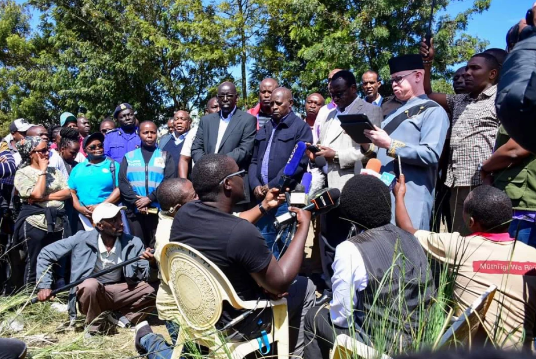The death toll from the tragic fire at Endarasha Hillside Academy in Nyeri County has risen to 21, government officials confirmed on Saturday. Prosecutors have directed the police to investigate whether negligence or recklessness contributed to the disaster, pledging that anyone found responsible will be held accountable.
The fire broke out in a dormitory at the primary school in Nyeri County around midnight on Thursday, while more than 150 boys aged between 9 and 13 were asleep. According to government spokesman Isaac Mwaura, 19 bodies were recovered from the scene, and two more victims succumbed to their injuries in the hospital.
Of the 156 boys present in the dormitory at the time of the fire, 139 have been accounted for, either at home or in the hospital, Mwaura added.
“It is a catastrophe beyond our imagination,” Mwaura said at a press briefing at the site.
“It is truly devastating for the nation to lose such a number of young and promising Kenyans. Our hearts are heavy.”
The cause of the fire remains unknown, but homicide investigators and forensic experts are currently at the school, where media access has been restricted. The victims’ charred remains, described by police as burnt beyond recognition, were discovered in the dormitory, now reduced to a blackened shell with its collapsed corrugated iron roof.
Chief government pathologist Johansen Oduor announced that postmortems would begin on Tuesday. Meanwhile, Director of Public Prosecutions Renson Ingonga has instructed the police to conduct a thorough investigation into the circumstances surrounding the fire.
The investigation will assess whether negligence or recklessness on the part of those responsible played a role in the tragedy, according to a statement from his office. Any individuals found culpable will face criminal prosecution.
The fire has brought attention to safety concerns in Kenyan schools, following a history of similar incidents. The National Gender and Equality Commission noted that initial reports indicated the dormitory was “overcrowded, in violation of safety standards.”
Ruto has declared three days of national mourning from Monday after what he described as an “unfathomable tragedy”.
Pope Francis expressed deep sorrow over the tragic loss of young lives, extending his “spiritual closeness” to those affected by the calamity, especially the injured and grieving families.
As families anxiously awaited news about their loved ones, one distraught mother at the school cried out, “We don’t want the food donations. We want our children.”
To support those impacted, the Kenya Red Cross has set up white tents outside the school gates, offering psychological counseling sessions for traumatized children and their relatives.
Muchai Kihara, 56, rushed to the school around 1 a.m. on Friday and was relieved to find his 12-year-old son, Stephen Gachingi, alive. “I cannot begin to imagine what he went through. I am happy he is alive, but he had injuries at the back of his head, and the smoke affected his eyes,” he told AFP. “I just want him to receive counseling to help him return to normal life.”
Tragic incidents like this have plagued schools in Kenya and across East Africa in recent years. In 2016, a fire at a girls’ high school in Nairobi’s Kibera slum claimed the lives of nine students. In 2001, an arson attack on a secondary school dormitory in Machakos, south of Nairobi, killed 67 students.
Two pupils were charged with murder, while the headmaster and deputy were convicted of negligence.
In 1994, a fire at a girls’ school in Tanzania’s Kilimanjaro region killed 40 children and injured 47 others. More recently, in 2022, a blaze at a school for the blind in eastern Uganda claimed the lives of 11 pupils who were trapped inside their burglar-proofed dormitory, according to government officials.



